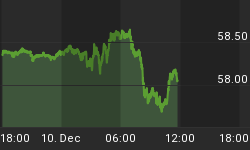The following is part of Pivotal Events that was published for our subscribers June 9, 2011.
SIGNS OF THE TIMES:
"Horror For US Economy as Data Falls Off Cliff" ~ CNBC, June 1, 2011
"Next Stop: Dow 20,000"
"10 Reasons Why the Market Will Soar" ~ MarketWatch, June 2, 2011
In 1999 James K. Glassman published a best-selling book, Dow 36,000. Advice included the assertion that the book "will convince you of the single most important fact about stocks at the dawn of the twenty-first century: They are cheap....If you are worried about missing the market's big move upward, you will discover that it is not too late. Stocks are now in the midst of a one-time-only rise to much higher ground - to the neighborhood of 36,000 on the Dow Jones industrial average."
Last week's "Dow 20,000" reveals a vibrant bullish spirit tempered by an interesting degree of caution not seen with the 36,000 number.
"The [Greek] government is under huge pressure, not from hooded radicals who battled police in the early days of the austerity drive, but from ordinary Greeks who are suffering badly." ~ YahooNews , June 5, 2011
Public protest is changing from government union thugs to ordinary people. The uprising seems to be shifting from the influence of neurotic intellectuals to practical individuals. Let's hope that democracy is returning to Greece, which is not the only county in need of more freedom from government intrusion.
Socrates observed "The unexamined life is not worth living." Far too many intellectuals from, well, Plato to Marx have considered that the "un-coerced life is not worth living". Legions of those who suffered the gulags that go with social experiments by philosopher kings attest to the irony in the latter phrase.
"66% say that government employees work less and make more money than workers employed by private companies." ~ Rasmussen, June 8, 2011
Revolting!
Is The Bar Closing?
The old saying is that "When the Fed is the bartender, everyone drinks until they fall down". This has been the case with central bankers around the world who all have the same ambition to depreciate, but have different abilities to execute. Even in policy-land all are not equal in result.
It seems that the last of the revelry culminated in April, which was within our target window for the completion of the speculative surge.
The final stage focused upon precious metals and crude oil. Other games lost focus earlier. Shanghai, Hong Kong and India reached their cyclical highs last November. The Nikkei set its high a year ago. The leadership from projected powerful growth trends in Asia seem to be placed in doubt by fading stock exchanges.
On the US stock market, our target for the S&P has been the March low of 1249. While equities have been vulnerable to that level, if the S&P is steady through Friday, a weekly Downside Capitulation would register. In which case a relief rally would follow. It need not get to 1249 to rebound.
The likely dampener to a rebound is the change in credit conditions. "They" may be debating QE3, but tides are no longer favourable.
The yield curve reversal to steepening has been modest but an indicator of change. However, the reversal in credit spreads is telling a stronger story.
The benchmark Sub-Prime mortgage bond broke down a month ago at 55. In the past week it has plunged from 53.66 to 47.40.
The low in March 2009 was 23.10. The rebound high was 62.50 in February, so the break down is significant.
Back in the raptures about the Sub-Prime and the housing boom the representative mortgage bond was trading at 100. When this sector turned down in early 2007 it presaged financial disaster.
This was confirmed in that fateful May when corporate spreads reversed to widening.
This time around, the representative High-Yield narrowed to 336 bps, over treasuries, in mid-April and widened to 361 bps two weeks ago. Now it's at 417 bps. 81 beeps of widening is noteworthy.
Can serious financial troubles happen again? So soon?
Problems in Sovereign Debt are encompassing the Sub-Prime as well as corporate markets.
The bar is closing in the credit markets.
PRECIOUS METALS
This sector offered big signals for a reversal in the latter part of April. The main one was the Momentum Trifecta on registering Upside Exhaustions for silver and the silver/gold ratio on the Daily, Weekly and Monthly calculations.
This was an exceptional reading and unlikely to be repeated for many years. In the meantime, the simpler reading of momentum is the RSI, which reached 92. This was also the "sell" signal.
After a spectacular zoom and hit, silver and the silver/gold ratio has been recovering and could continue for a few weeks more.
However, the message from the ratio is that another phase of liquidity problems is pending and that will release the next rally in the dollar.
This will keep senior gold stocks down, but over the summer low prices for the juniors could provide some opportunities. Particularly those with good drilling results within a lengthy exploration program.
On the constructive side, gold's real price continues to improve. This, in increasing from 303 in February has been confirming the start of the next recession when weakening prices will boost our Gold/Commodities Index even further.
In the post-2007 financial crash it soared to 519, which with the uptrend now being extended becomes our target.
A doubling of the gold's price relative to commodities is possible and that would enhance the sector considerably. In so many words, a typical post-bubble contraction is being accompanied by a long bull market for operating margins for the gold sector.
A good as this will be, stocks will continue to have intermediate swings that should be traded,
Sub-Prime Mortgage Bonds

- While the instrument is synthetic, the chart is real.
- The breakdown in early May is important.
Link to June 10, 2011 'Bob and Phil Show' on Howestreet.com: http://talkdigitalnetwork.com/2011/06/dow-falls-sky-follow
















